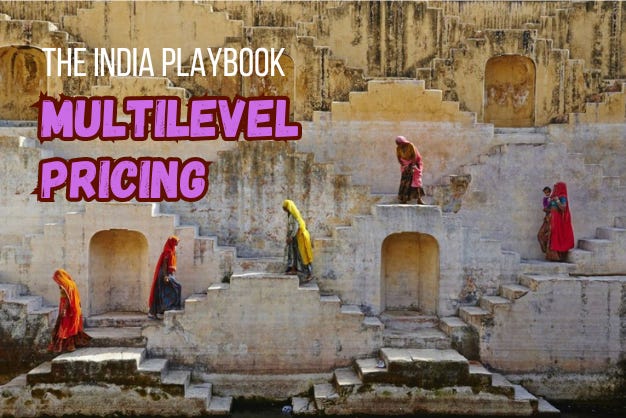The India Playbook: Multilevel pricing
India contains multitudes and demands a fit-to-context playbook. I explore ten insights into the Indian market over ten emails.Part VII: Multilevel pricing
Newsletter on ideas that help marketers do better and be better. Subscribe here.
Over the next few weeks, you will receive ten short emails from me. Each mail will decode one insight about India and what it means for business.
Part VII: Multilevel pricing
Large successful brands that reach at least three of the four Indias adopt the critical strategy of multilevel pricing.
India is like a vast mall with three floors and one penthouse. Each floor has a distinct consumption capacity and preferred price points. As income grows, people on the lower floors start ascending - a household that buys a Re.1 shampoo sachet moves to Rs.2 and so on. The opposite happens during a downturn.
That’s why, brands that operate at multiple price levels capture share of wallet from throngs of consumers riding up and down.
This golden rule applies to all categories. Take a look at Parle G and Jio Prepaid. Both operate across price tiers - I can almost visualize consumers going up and down the ladder in the chart below!
A fascinating set of insights emerge
The kind of value that tech adds to a consumer’s life cannot be denied: while ParleG starts at Rs.3/- and goes up to Rs.120, the lowest Jio price is Rs.79/- more than the highest ParleG price
Having said that, given that Indians have a constrained cash flow, tech brands have not vacated magic price points - the pre-paid top-up for Jio starts at a price of Rs.15/-
Slow and steady growth vs shock entry: While Parle G is 94 years old and has stayed at these magic price points, Jio launched just eight years ago (in 2015) and offered free talktime+data for almost a year to get to this present state.
Operational complexity. Operationally, both a telecom network and a biscuit factory involve huge capital investments. But a telecom company can have as many SKUs (stock keep units) as there are consumers - once the ‘data pipes’ are built, whether you buy 1GB or 0.63GB, it does not matter. But for a consumer goods company, more SKUs mean more complexity and cost - notice how ParleG has kept all its multi-packs at 130g.
Lastly, a higher price point does not mean a richer consumer. The affluent Indian may buy the Rs.3/- pack for themselves as a portion-controlled snack. They may also buy the Rs.120/- multi-pack to distribute to kids in temples or at streetlights. Likewise, an affluent Indian might also be found at a Rs.479/- prepaid plan.
That’s what makes the market so complicated… and so interesting. You never know which consumer will upgrade or downgrade to which price point.
Thanks for reading.
Poll
You have read 7/10 of The India Playbook.






